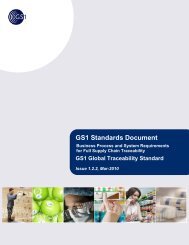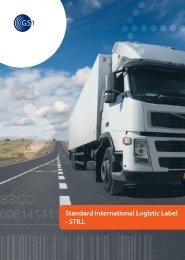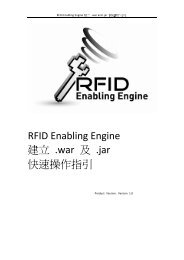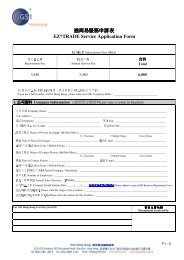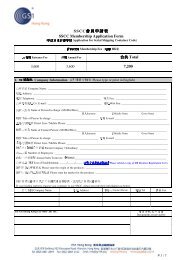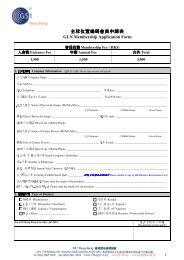Wine Supply Chain Traceability - GS1
Wine Supply Chain Traceability - GS1
Wine Supply Chain Traceability - GS1
You also want an ePaper? Increase the reach of your titles
YUMPU automatically turns print PDFs into web optimized ePapers that Google loves.
<strong>Wine</strong> <strong>Supply</strong> <strong>Chain</strong> <strong>Traceability</strong>achieved. Manufacturers and retailers, large and small companies can participate.Achieving proper alignment is the main driver for recommending companies toassess their current position and to consider implementing best practice asdescribed in <strong>GS1</strong> standards 6 .Throughout this process a collaborative approach is recommended includingdialogue between all supply chain partners. This dialogue will lead to theidentification of all essential supply chain information and material flows to bereceived, handled and generated within a company‟s boundaries and at interfacesbetween the company and its trading partners (e.g. at receiving and dispatch ofmaterials and finished goods). The important information that must be properlyrecorded and exchanged includes:• Identification of all supply chain partners through unambiguous coding usingthe Global Location Number (GLN)• Identification of all unique products using the Global Trade Item Number(GTIN)• Identification of logistic units using the Serial Shipping Container Code(SSCC)• Bar coding of trade items and logistic units with appropriate <strong>GS1</strong> bar codes• Precise and cost efficient electronic data interchange using standardelectronic message formats (EANCOM ® or <strong>GS1</strong> XML)A clear analysis should be completed to identify and describe the current status ofyour company organisation, IT systems and business processes (“as is”) and ananalysis should be prepared to describe the desired future status (“to be”). Theanalysis of the current practices of the wine supply sector and their expected futuredevelopment are to be taken into account in order to assess the timeframe neededto reach a critical mass of players for implementation. This will help identify anddocument the steps required to implement a migration programme and achieve asuccessful implementation of standards including:• Organisational changes• Investments in technology• Integration of new technology process designsThe final key step in the migration plan is to find the best sequence in which toimplement the solution, starting with organisational change and driving intotechnological implementation whilst preserving the benefits achieved through eachstep of the process improvements. All steps developed should be documentedincluding investment, impact and expected improvements and results. Anestablished timeline taking account of legislation, coupled with sound economicanalysis is the backbone of the migration plan.6.4. Self Assessment ScorecardA self-assessment scorecard should be developed to measure the degree ofcompliance and implementation of best practice. This self-assessment can bepresented as a checklist with a score that indicates the degree of implementation6GEPIR allows our members to use the Internet to look for a company (by itsGLN), a product (by its GTIN) and shipment identification (by its SSCC). Formore information, please see www.gepir.orgPage 21 of 28



